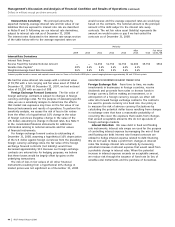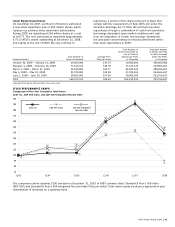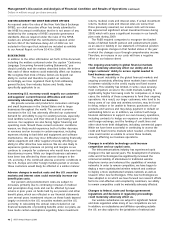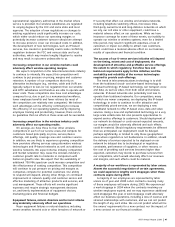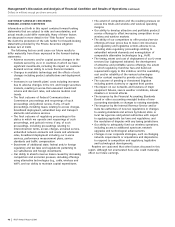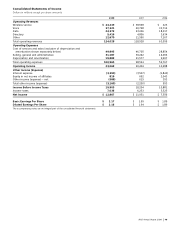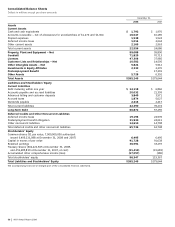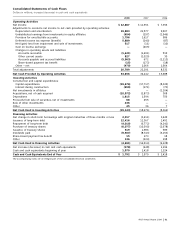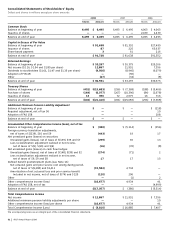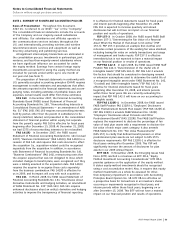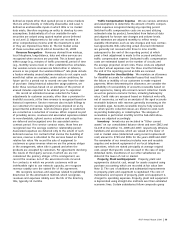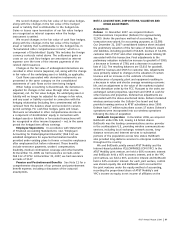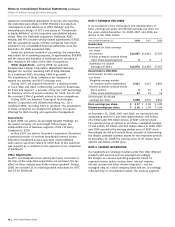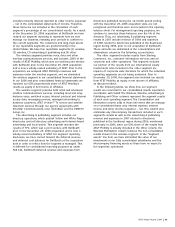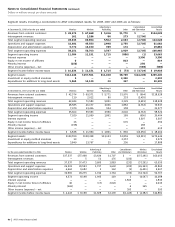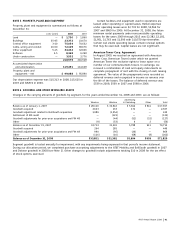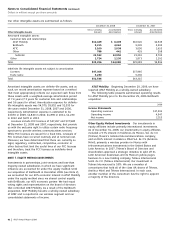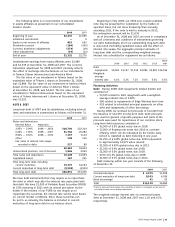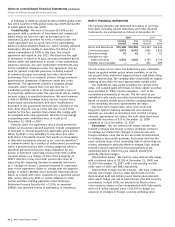AT&T Wireless 2008 Annual Report Download - page 56
Download and view the complete annual report
Please find page 56 of the 2008 AT&T Wireless annual report below. You can navigate through the pages in the report by either clicking on the pages listed below, or by using the keyword search tool below to find specific information within the annual report.
Notes to Consolidated Financial Statements (continued)
Dollars in millions except per share amounts
54
| AT&T Annual Report 2008
EITF 08-7 In November 2008, the EITF reached a
consensus on EITF 08-7, “Accounting for Defensive Intangible
Assets.” EITF 08-7 provides that intangible assets that an
acquirer intends to use as defensive assets, intangible assets
acquired in a business combination or an asset acquisition
that an entity does not intend to actively use but does intend
to prevent others from using, are a separate unit of account
from the existing intangible assets of the acquirer. It also states
that a defensive intangible asset should be amortized over
the period that the fair value of the defensive intangible asset
diminishes. EITF 08-7 is effective on a prospective basis for
transactions occurring in fiscal years, and interim periods within
those fiscal years, beginning on or after December 15, 2008.
This EITF will require AT&T to recognize at fair value certain
assets associated with trademarks for the non-surviving
companies of acquisitions and amortize these trademarks
over the period they are expected to contribute directly or
indirectly to the entity’s future cash flows.
Valuation and Other Adjustments Included in the current
liabilities reported on our consolidated balance sheet are
accruals established under EITF 95-3, “Recognition of Liabilities
in Connection with a Purchase Business Combination” (EITF
95-3). The liabilities include accruals for severance, lease
terminations and equipment removal costs associated with our
acquisitions of AT&T Corp., BellSouth Corporation (BellSouth)
and Dobson Communications Corporation. Following is a
summary of the accruals recorded under EITF 95-3 at
December 31, 2007, cash payments made during 2008 and
the adjustments thereto.
12/31/07 Cash Adjustments 12/31/08
Balance Payments and Accruals Balance
Severance accruals
paid from:
Company funds $ 540 $(321) $(79) $140
Pension and
postemployment
benefit plans 129 (26) — 103
Lease terminations 425 (110) 72 387
Equipment removal
and other
related costs 161 (62) (11) 88
Total $1,255 $(519) $(18) $718
Split-Dollar Life Insurance In 2007, the EITF ratified
the consensus on EITF 06-4, “Accounting for Deferred
Compensation and Postretirement Benefit Aspects of
Endorsement Split-Dollar Life Insurance Arrangements”
(EITF 06-4) and EITF 06-10 “Accounting for Collateral
Assignment Split-Dollar Life Insurance Arrangements”
(EITF 06-10). EITF 06-4 and EITF 06-10 cover split-dollar
life insurance arrangements (where the company owns and
controls the policy) and provides that an employer should
recognize a liability for future benefits in accordance with
Statement of Financial Accounting Standards No. 106,
“Employers’ Accounting for Postretirement Benefits Other
Than Pensions” (FAS 106). These are effective for fiscal years
beginning after December 15, 2007. We adopted EITF 06-4
and EITF 06-10 on January 1, 2008, recording additional
postretirement liabilities of $101 and a decrease to retained
earnings of $63.
Reclassifications We have reclassified certain amounts
in prior-period financial statements to conform to the current
period’s presentation.
Income Taxes We adopted Financial Accounting
Standards Board Interpretation No. 48 “Accounting for
Uncertainty in Income Taxes” (FIN 48) on January 1, 2007.
With our adoption of FIN 48, we provide deferred income
taxes for temporary differences between the carrying
amounts of assets and liabilities for financial reporting
purposes and the tax basis of assets and liabilities
computed pursuant to FIN 48. Under FIN 48, the tax bases
of assets and liabilities are based on amounts that meet
the FIN 48 recognition threshold and are measured
pursuant to the measurement requirement in FIN 48.
To the extent allowed by GAAP, we provide valuation
allowances against the deferred tax assets for which the
realization is uncertain. We review these items regularly
in light of changes in federal and state tax laws and
changes in our business.
Investment tax credits earned prior to their repeal by the
Tax Reform Act of 1986 are amortized as reductions in income
tax expense over the lives of the assets, which gave rise to
the credits. Additionally, we report taxes imposed by govern-
mental authorities on revenue-producing transactions between
us and our customers in the income statement on a net basis.
Cash Equivalents Cash and cash equivalents include all
highly-liquid investments with original maturities of three
months or less and the carrying amounts’ approximate fair
value. At December 31, 2008, we held $958 in cash and
$834 in money market funds and other cash equivalents.
Investment Securities Investments in securities principally
consist of available-for-sale instruments. Short-term and
long-term investments in money market securities are carried as
held-to-maturity securities. Available-for-sale securities consist
of various debt and equity securities that are long term in
nature. Unrealized gains and losses, net of tax, on available-
for-sale securities are recorded in accumulated other compre-
hensive income. Our investment securities maturing within
one year are recorded in “Other current assets” and instruments
with maturities of more than one year are recorded in “Other
Assets” on the consolidated balance sheets. Unrealized losses
that are considered other than temporary are recorded in Other
Income (Expense) with the corresponding reduction to the
carrying basis of the investment (see Note 11).
Statement of Financial Accounting Standards No.157,
“Fair Value Measurements” (FAS 157) requires disclosures for
financial assets and liabilities that are remeasured at fair value
at least annually. FAS 157 establishes a three-tier fair value
hierarchy, which prioritizes the inputs used in measuring fair
value. These tiers include: Level 1, defined as observable
inputs such as quoted prices in active markets; Level 2,


